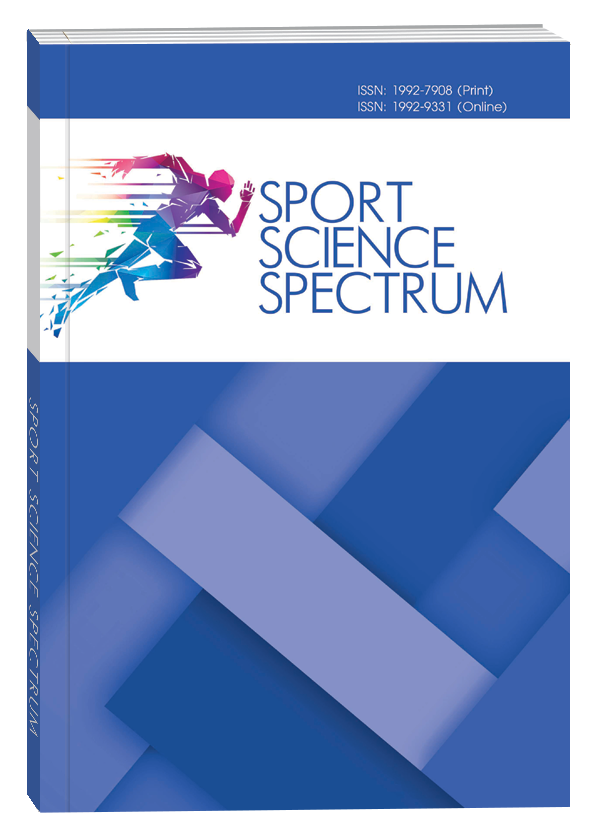THE CONCEPT OF IMPROVING THE MANAGEMENT SYSTEM OF TRAINING AND COMPETITION LOADS OF QUALIFIED ATHLETES IN ROWING
DOI:
https://doi.org/10.32782/spectrum/2024-4-7Keywords:
rowing, management, special performance, functionality, systematic approach, concept, technologyAbstract
The article is devoted to the substantiation of the concept and the development of technology for improving the management of training and competition loads of qualified athletes in rowing.Research methods: general scientific methods, theoretical research methods (methods of conceptual-comparative and structural-systemic analysis).Analysis of special literature and Internet sources. Meta-analysis.Research results. The paper presents a new solution to the scientific problem of improving the management of training and competition loads in the process of training qualified athletes in rowing, which is defined as: contradictions between the formed ideas about the management of the training process of athletes and insufficient substantiation of the interdependence and interconnection of the constituent elements of management; the absence of a systematic analysis of the factors of functional support of special working capacity, which determine the specialized orientation of the training process of qualified athletes in accordance with the implementation of the structure of competitive rowing activities.To increase the efficiency of the training process and the effectiveness of competitive activities, the concept of improving the management of training and competitive loads and the technology of its implementation in the process of training qualified athletes in rowing have been developed. Improving the management of training and competition loads of athletes is based on the development, formalization and algorithmization of the structure of systemically connected elements of “modeling – programming” of the training process in rowing, taking into account the general and individual factors of the preparedness of qualified athletes.
References
1. Ахметов P. Теоретико-методичні основи управління системою багаторічної підготовки спортсменів швидкісно-силових видів спорту (на матеріалі дослідження стрибків у висоту) : дис. … докт. наук з фіз. вихов. і спорту : 24.00.01. Житомир : Житомир. держ. ун-т ім. І. Франка, 2006. 467 с.
2. Богуславська В., Еделєв О., Поляк В. Вдосконалення фізичної підготовленості веслувальників різними режимами тренувань на етапі спеціалізованої базової підготовки. Фізична культура, спорт та здоров’я нації. 2023. № 16. С. 54–59.
3. Богуславська В. Статеві особливості розвитку функціональних резервів кардіореспіраторної системи веслувальників на етапі попередньої базової підготовки. Вісник Прикарпатського університету. Серія «Фізична культура». 2013. № 18. С. 91–96.
4. Ван Вейлун, Дяченко А. Специфічні характеристики спеціальної витривалості кваліфікованих веслувальників на байдарках на дистанції 1 000 м. Теорія і методика фізичного виховання і спорту. 2018. № 2. С. 8–13.
5. Ван Вейлун, Дяченко А. Контроль спеціальної працездатності кваліфікованих веслувальників на байдарках і каное на дистанції 500 і 1 000 м. Теорія і методика фізичного виховання і спорту. 2018. № 3. С. 10–14.
6. Го П., Кун С., Довгодько Н., Дяченко А., Го Р. Системний підхід до організації функціональної підготовки спортсменів високого класу. Спортивна наука та здоров’я людини. 2022. Вип. 1 (7).
7. Коваленко С., Гречуха С. Динаміка проходження кілометрової дистанції у веслуванні на байдарках та каное на чемпіонатах світу 2009–2011 рр. Педагогіка. 2011. Вип. 10. С. 33.
8. Коваленко Ю., Тищенко В., Шипенко А., Овдеєнко А. Удосконалення програми підготовки веслярів відповідно до їхнього типу індивідуальної рухової схильності. Вісник Запорізького національного університету. Серія «Фізичне виховання та спорт». 2020. № 2. С. 133–139. URL: https://doi.org/10.26661/2663-5925-2020-2-20.
9. Костюкевич В. Моделювання в системі підготовки спортсменів високої кваліфікації. Фізична культура, спорт та здоров’я нації : збірник наукових праць. Вінниця : ВДПУ ім. М. Коцюбинського, 2014. Вип. 18. С. 92–102.
10. Костюкевич В., Шинкарук О., Врублевський Є. Теоретико-методичні аспекти програмування та моделювання тренувального процесу спортсменів різної кваліфікації. 2021.
11. Омельченко О. Вдосконалення силової та спеціальної витривалості веслярів у прибережному веслуванні на етапі спеціалізованої базової підготовки. Редакційна колегія. 2022. 79 с.
12. Платонов В. Сучасна система спортивного тренування. Перша друкарня, 2020. 704 с.
13. Сватьєв А., Гостіщев В. Модельні програми в організації тренувальних занять з академічного веслування. Педагогіка, психологія та медико-біологічні проблеми фізичного виховання і спорту. 2010. № 5. С. 34–39.
14. Спичак Н. Реалізація функціональних можливостей кваліфікованих веслувальників-байдарочників на різних змагальних дистанціях : авто- реф. дис. … канд. наук з фіз. вихов. і спорту : 24.00.01. Київ : Нац. ун-т фіз. виховання і спорту України, 2010. 24 с.
15. Тищенко В., Лисенчук Г. Аналіз сучасних підходів до використання інноваційних технологій для вдосконалення спеціальної фізичної та техніко-тактичної підготовки у спорті. Науковий часопис Національного педагогічного університету імені М.П. Драгоманова. Серія 15 «Науково-педагогічні проблеми фізичної культури (фізична культура і спорт)». Київ : НПУ ім. М.П. Драгоманова, 2019. Вип. 6. С. 99–104.
16. Філіппов М. Фізіологічні умови поетапного забезпечення максимального споживання кисню у спортсменів. Науковий часопис Національного педагогічного університету імені М.П. Драгоманова. Серія 15 «Науково-педагогічні проблеми фізичної культури (фізична культура і спорт)». Київ : НПУ ім. М.П. Драгоманова, 2017. Вип. 3K. С. 485–488.
17. Шинкарук О., Тайболіна Л. Функціональний стан серцево-судинної системи веслувальників високої кваліфікації в процесі інтенсивної змагальної діяльності. Спортивна медицина, фізична терапія та ерготерапія. 2020. Вип. 1. С. 49–60.
18. Шинкарук О., Коженкова М. Розробка моделі проходження змагальної дистанції українським екіпажем жіночої четвірки парної у веслуванні академічному. Молодь та олімпійський рух : матеріали 10-ої Міжнародної конференції молодих учених, 24–25 травня 2017 р., м. Київ. Київ, 2017. С. 198–199.
19. Шкребтій Ю. Управління тренувальними і змагальними навантаженнями спортсменів високого класу в умовах інтенсифікації процесу підготовки : автореф. дис. … докт. наук з фіз. вихов. і спорту : 24.00.01. Київ, 2006. 40 с.
20. Alacid F., Carrasco L. Distribución del esfuerzo en piragüismo sobre 1000 metros. 3 Congreso de la Asociación Española de Ciencias del Deporte / Universidad de Valencia. Valencia, 2004. URL: https://doi.org/10.33262/cde.4.
21. Binnie M.J., Astridge D., Watts S.P., Goods P.S., Rice A.J., Peeling P. Quantifying on-water performance in rowing: A perspective on current challenges and future directions. Frontiers in Sports and Active Living. 2023. Vol. 5.
22. Bishop D., Bonetti D., Dawson B. The influence of pacing strategy on V̇O2 and supramaximal kayak performance. Med. Sci. Sports Exerc. 2002. Vol. 34. № 6. P. 1041–1047. URL: https://doi.org/10.1097/00005768-200206000-00022.
23. Bompa T.O. Total training for coaching team sport. Toronto : Sport books publisher, 2006. 285 p.
24. Bompa T.O., Buzzichelli C. Periodization: Theory and Methodology of Training. Sixth ed. Champaign IL : Human Kinetics, 2018. 392 p.
25. Cerasola D., Bellafiore M., Cataldo A., Zangla D., Bianco A., Proia P., Traina M., Palma A., Capranica L. Predicting the 2000-m Rowing Ergometer Per- formance from Anthropometric, Maximal Oxygen Uptake and 60-s Mean Power Variables in National Level Young Rowers. J. Hum. Kinet. 2020 Oct 31. Vol. 75. P. 77–83. URL: https://doi.org/10.2478/hukin-2020-0038.
26. Hill D.W. The critical power concept : a review. Sport Med. 1993. Vol. 16. № 4. P. 237–254.
27. Kleshnev V. Comparison of on-water rowing with its simulation on Concept 2 and Rowperfect mashines. Scientific proceedings. XXII International Symposium on Biomechanics in Sports. Beijing, 2005. P. 130–133.
28. Kleshnev V. Boat acceleration, temporal structure of the stroke cycle, and effectiveness in Kayak. J. Sports Eng. Technol. 2010. Vol. 224. № 1. P. 63–74.
29. Kleshnev V. The Biomechanics of rowing. Marlborough : Crowood Press, 2016. 192 p.
30. Kleshnev V. Biomechanics of rowing: a unique insight into the technical and tactical aspects of elite rowing. 2nd ed. Marlborough : The Crowood Press, 2020. 192 p.
31. Larochelambert Q., Del Vecchio S., Leroy A., Duncombe S., Toussaint J.-F., Sedeaud A. Body and Boat: significance of morphology on elite rowing performance. Front. Sports Act. Living. 2020 Dec 2. Vol. 2. DOI: 10.3389/fspor.2020.597676.
32. Mischenko V., Monogarov V. Phisiology del deportista. Editorial Paidotribo, 1995. 328 p.
33. Nevill A.M., Beech C., Holder R.L., Wyon M. Scaling concept II rowing ergometer performance for differences in body mass to better reflect rowing in water. Scand. J. Med. Sci. Sports. 2010. Vol. 20. № 1. P. 122–127. URL: https://doi.org/10.1111/j.1600-0838.2008.00874.x.
34. Pendergast D., Mollendorf J., Zamparo P., Termin A., Bushnell D., Paschke D. The influence of drag on human locomotion in water. Undersea & Hy- perbaric Med. 2005. № 32. P. 45–57.
35. Petrovic M.R., García-Ramos A., Janicijevic D.N., Pérez-Castilla A., Knezevic O.M., Mirkov D.M. The Novel Single-Stroke Kayak Test: Can It Discriminate Between 200-m and Longer-Distance (500- and 1 000-m) Specialists in Canoe Sprint. Int. J. Sports Physiol. Perform. 2021 Feb. Vol. 16. № 2. P. 208–215. URL: https://doi.org/10.1123/ijspp.2019-0925.
36. Reliabilty and validity of a discontinous graded exercise test on Dansprint [R] ergometer / L. Carrasco Paez et al. Ovidius University Annals. Series Physical education and sport/science, movement and health. 2010. Vol. 10. № 2. P. 148.
37. Soper C., Hume P. A. Reliability of power output during rowing changes with ergometer type and race distance. Sports Biomech. 2004 Jul. Vol. 3. № 2. P. 237–248. DOI: 10.1080/14763140408522843.
38. Stadler A.T., Schönauer M., Aslani R., Baumgartner W., Philippi T. The Impact of a Flexible Stern on Canoe Boat Maneuverability and Speed. Biomimet- ics (Basel). 2020 Mar. Vol. 5. № 1. P. 7. URL: https://doi.org/10.3390/biomimetics5010007.
39. Vogler A.J., Rice A.J., Gore C.J. Physiological responses to ergometer and on-water incremental Kayak tests. Int. J. Sports Physiol. Perform. 2010. Vol. 5. № 3. P. 342–358.
40. Vynohradov V., Osypenko G., Ilyin V., Vynogradova O., Rusanova O. Effect of special exercises on blood biochemical indices in highly skilled ath- letes of cyclic sports events with endurance manifestation during pre-start preparation. J. Phys. Educ. Sport. 2020. Vol. 20. № 5. Art 371. P. 2725–2734. URL: https://doi.org/10.7752/jpes.2020.05371.
41. Vynohradov V., Osypenko G., Ilyin V., Vynogradova O., Rusanova O. Effect of special exercises on blood biochemical indices of highly skilled male rowers during pre-start preparation. J. Phys. Educ. Sport. 2021. Vol. 21. № 1. Art. 31. P. 236–242. URL: https://doi.org/10.7752/jpes.2021.01031.
42. Wallace L.K., Slattery K.M., Coutts A.J. A comparison of methods for quantifying training load: relationships between modelled and actual training responses. Eur. J. App. Physiol. 2014. Vol. 114. № 1. P. 11–20. URL: https://doi.org/10.1007/s00421-013-2745-1.
43. Ye C., Pengcheng G., Rusanova O., Diachenko A., Nikonorov D. The Use of Ergometry in the Kayakers’ Special Physical Conditioning. Sport Mont. 2021. Vol. 19. № S2. P. 119–124. DOI: 10.26773/smj.210920.





